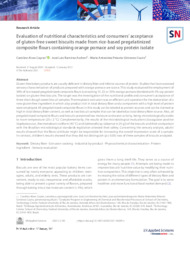Evaluation of nutritional characteristics and consumers' acceptance of gluten-free sweet biscuits made from rice-based pregelatinized composite flours containing orange pomace and soy protein isolate.
Evaluation of nutritional characteristics and consumers' acceptance of gluten-free sweet biscuits made from rice-based pregelatinized composite flours containing orange pomace and soy protein isolate.
Author(s): CAYRES, C. A.; ASCHERI, J. L. R.; COUTO, M. A. P. G.
Summary: Gluten-free bakery products are usually deficient in dietary fiber and inferior sources of protein. Studies that have assessed sensory characterization of products prepared with orange pomace are scarce. This study evaluated the employment of 30% of rice-based pregelatinized composite flours (containing 15, 25 or 35% orange pomace blended with 5% soy protein isolate) on gluten-free biscuits. The target was the investigation of the nutritional profile and consumer?s acceptance of three short dough sweet biscuit samples. Thermoplastic extrusion was an efficient unit operation for the elaboration of a new gluten-free ingredient in which a by-product rich in total dietary fiber and a component with a high level of protein were employed. All pregelatinized composite flours in this study can be labeled as protein sources and can be claimed as high in total dietary fiber content, as well as two biscuit samples that can be labeled as total dietary fiber source. Also, all pregelatinized composite flours and biscuits presented low moisture and water activity, being microbiologically stable to room temperature (25?±?2 °C). Complementarily, the results of the microbiological evaluations [(coagulase-positive Staphylococcus, thermotolerant coliform (45 °C) and Salmonella sp. (absence in 25 g)] of the biscuits and their comparison with the Brazilian microbiological standards legislation attested their safety. Concerning the sensory analysis, adults? results showed that the flavor attribute might be responsible for increasing the overall impression score of a sample. In contrast, children?s results showed that they did not distinguish (p???0.05) two of three samples of biscuits analyzed.
Publication year: 2021
Types of publication: Journal article
Unit: Embrapa Food Technology
Observation
Some of Embrapa's publications are published as ePub files. To read them, use or download one of the following free software options to your computer or mobile device. Android: Google Play Books; IOS: iBooks; Windows and Linux: Calibre.
Access other publications
Access the Agricultural Research Database (BDPA) to consult Embrapa's full library collection and records.
Visit Embrapa Bookstore to purchase books and other publications sold by Embrapa.

